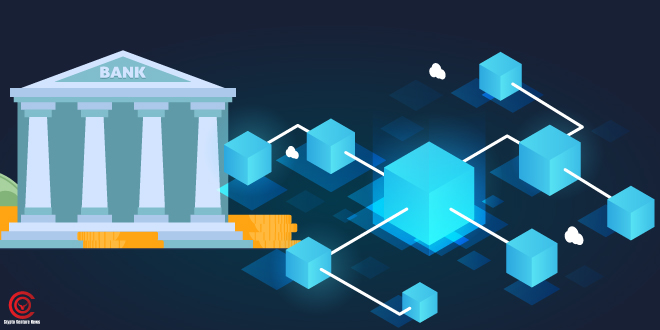The blockchain domain has been flourishing in recent years, the reason being people’s belief in its unseen potential. It has also given rise to cryptocurrency, NFT, and metaverse, which in turn have revolutionized several other sectors. Moreover, blockchain has also been integrated into the banking sector. The fusion of blockchain in banking is not an unusual combo as you might think.
Read further to know how the incorporation of blockchain in the banking sector has been working and how financial literacy is important for the same. But yes, the ones who do not know what is blockchain should first know about it, therefore, that will be the first topic of discussion.
What Is Blockchain?
Blockchain is a technology that operates on the Distributed Ledger Technology (DLT), wherein, all transactions and data are saved in individual blocks. The technology has been used to build cryptocurrencies around the world and it even gave rise to the first and biggest digital currency, Bitcoin (BTC).
In addition, the Web 3.0 ecosystem also came into existence, which altered the entire digital world as well. It is observed as one of the technologies that have immense potential that has unexplored factors that might emerge helpful in the future. It has been integrated into several fields around the globe (we would be discussing blockchain and banking, one of the most popular implementations in the domain).
What Is Financial Literacy?
Since the topic mentions financial literacy in the blockchain in banking, let’s get to know what it means actually. Financial Literacy is defined as the understanding of important financial skills that hover around investing, saving, budgeting, and expenditure. It ensures that one knows about their earning capabilities and then plans a budget to spend, invest and save it. In absence of financial literacy, it would be detrimental for the person as they might run out of funds and might end up doing poor future planning.
In addition, when the blockchain domain is concerned, being financially literate is extremely vital due to the underlying risks that this sector hosts. We have discussed the need for it in the article hereafter, which also covers blockchain in financial services that are not directly related to banking.
How Blockchain In Banking Works? Why It Needs Financial Literacy?
Blockchain and banking have been closely related for ages now. This is because the currencies based on the technology are processed through the banking sector when any kind of trade is made. Experts in the banking sector agree that the integration of blockchain technology in banking is extremely helpful for users. Jason Juliano, Director at EisnerAmper Digital, commented on the same saying:
“Blockchain networks enable customers to execute transactions faster and cheaper across banking platforms. But the changes it’s driving and will continue to drive, are not just operational. Historically, for example, when banks looked for new hires, they focused on candidates who had a background in banking and financial services—but now banks are increasingly looking for digital asset and blockchain talent.”
Juliano, however, mentioned that the regulatory bodies in the financial industry have not been able to comply with the advancement in the technology where blockchain in financial services is integrated. He added saying:
“Federal and other agencies are encouraging banks to adopt blockchain and crypto initiatives, but regulators also want tighter controls and strong governance. Regulations are still evolving, although I’d say that right now, the New York State Department of Financial Services is probably ahead of most agencies.”
But yes, even though there are hazards., people often like taking risks as the returns are far better. Therefore, let’s now discuss how blockchain in banking works together in today’s world. Further, we will also note how financial literacy is important in such situations.
Processing Digital Currency Based On Blockchain
Cryptocurrencies or the currencies that are based on blockchain are garnering immense popularity recently. This has been changing the banking sector’s working as well as the funds that have been transferred after these currencies are utilized for cashing out are processed through one’s bank. It is considered the main sector where blockchain and banking operate simultaneously. In addition, banks now have to process company transactions that incorporate cryptocurrency as a payment option. Banks have to be real quick in processing such transactions.
Further, the thing is that these currencies are extremely volatile and this is why their prices change within seconds, which is what the banks have to take care of. Moreover, financial literacy is important for a person and the ones who run a business to know the way this dynamic domain works. This is because they can plan their investments and savings out of the amount they have at the moment.
Also, preparing a budget for investing in the crypto domain is necessary for better returns. In addition, the banking sector also has to be well-versed in it as they have to process the transactions in an optimum manner to reduce issues at the end of both the sender and the receiver. This is due to the fact that even a delay of a few seconds or not noting the price at the time of the transaction might lead to problems at the end of the receiver.
Insurance Policy For Crypto
There are insurance companies that have been working on crypto insurance policies for protecting investors from the uncertain risks that the crypto domain hosts. Therefore, these have to be based on a premium charge basis, which of course the banks process. In addition, if they are entitled to returns from the policy in case of loss or damage of investment, even then the banks have to interfere. This is where financial literacy is very important as crypto investors have to make decisions on the amount to be used in investments and the insurance policies to consider among them.
However, another concern is that crypto insurance policies have witnessed a rise in demand amid a dearth of this facility. This is why in the future it might be difficult for the investor to choose from the available services. In addition, if the number of policies rises, then the pressure on banks for processing such transactions on a daily basis would be a lot.
Centralized Crypto Assets (CDBC Blockchain)
Most of the digital currencies or crypto assets are decentralized in nature today. However, there is a thing called ‘centralized crypto assets’ on which the central banks of several countries have been working on. These centralized crypto assets have to be regulated by the monetary authority of the country. Various nations have thought to have a check on the volatile crypto domain by developing their native currency known as Central Bank Digital Currencies (CBDCs).
These CDBC blockchain currencies are regulated and are said to alter the digital currency domain operations as a whole. This is because it will give the central bank regulators some authority to be exercised in the sector. This might lead to newer regulations that banks might have to adhere to. In addition, this would lead to updated knowledge when somebody is considered to be financially literate. Therefore, the entire investment or saving plans have to be rebuilt in such a case.
Crypto As A Collateral
Cryptocurrency has even emerged as collateral security for banks. It is not a procedure that most mainstream banks follow in recent years. However, with changing times they might have to risk and allow loans that require crypto as a collateral. Currently, most of the crypto exchanges like Binance and Coinbase have been offering such loans and borrowings in order to promote the use of crypto so that they can earn new customers. This is why the refusal of incorporating this facility is something that these platforms can’t do in the scenario of cut-throat competition. Blockchain in financial services that concern borrowing or lending also affect the banks.
In the case of banks, financial literacy is extremely important both for the officials and the users. This is because cryptocurrencies not only shoot up in value but also dump really fast. During crypto winter and prolonged crypto crash sessions, even the largest crypto, BTC, tumbled from its all-time high of about $69,000 to below $20,000 recently. This can be detrimental to the bank, especially, if digital currencies are considered as a collateral. Therefore, a proper plan should be devised by the authorities before implementing such changes in order to minimize the risks and the loss figure.
Private Blockchain Process Facilities
Private blockchain technology in banking is an integration that can be helpful to the latter if incorporated in an optimum manner. This is due to the fact that blockchain has immense potential that has yet not been explored. This can again be used in the lending process. However, this is a much safer option for the banks instead of considering crypto as collateral. This can be implemented by utilizing a private blockchain to process transactions between the debtors and the creditors. This will be beneficial in maintaining the records of such transactions that too without any errors or discrepancies.
This is because blockchain is efficient enough to maintain track records on its own. In addition, it also offers identity management options. This would ensure that the transactions made are safe and there is no chance of digital theft whatsoever. Private blockchain would allow banks to have complete authority over the system unlike the public ones as only the ones with permission can access it.
A Financially Literate Wrap-up
Blockchain in banking is a way of implementation that has been working hard to ease a lot of things for several domains in the world. The potential of blockchain and digital assets or other technologies based on it has helped the banking sector to grow. Moreover, banks now have been burdened with transactions that corporate businesses undertake in the form of cryptocurrency. Further, the use of private blockchain can help banks provide services to creditors and debtors for maintaining a record of transactions. This way blockchain potential can be harnessed for a lot more parties at the same time.
In addition, the fact that the CDBC blockchain system is going to be mainstream in the future is set to alter the way banks operate in the sector currently. Therefore, we should be prepared for such changes. This is where financial literacy would be in use for both banks and their customers in order to minimize the risks and be extremely cautious while undertaking any crypto or blockchain-related activities.
- AI Blockchain Projects: 8 Effective Ventures To Know Now - 03/08/2024
- Hyperledger Fabric: Why Has It Become So Famous? - 03/08/2024
- Ethereum Name Service: An Easy Step-By-Step Guide For You - 03/08/2024
 Crypto Venture News One stop Crypto Track Down
Crypto Venture News One stop Crypto Track Down 







